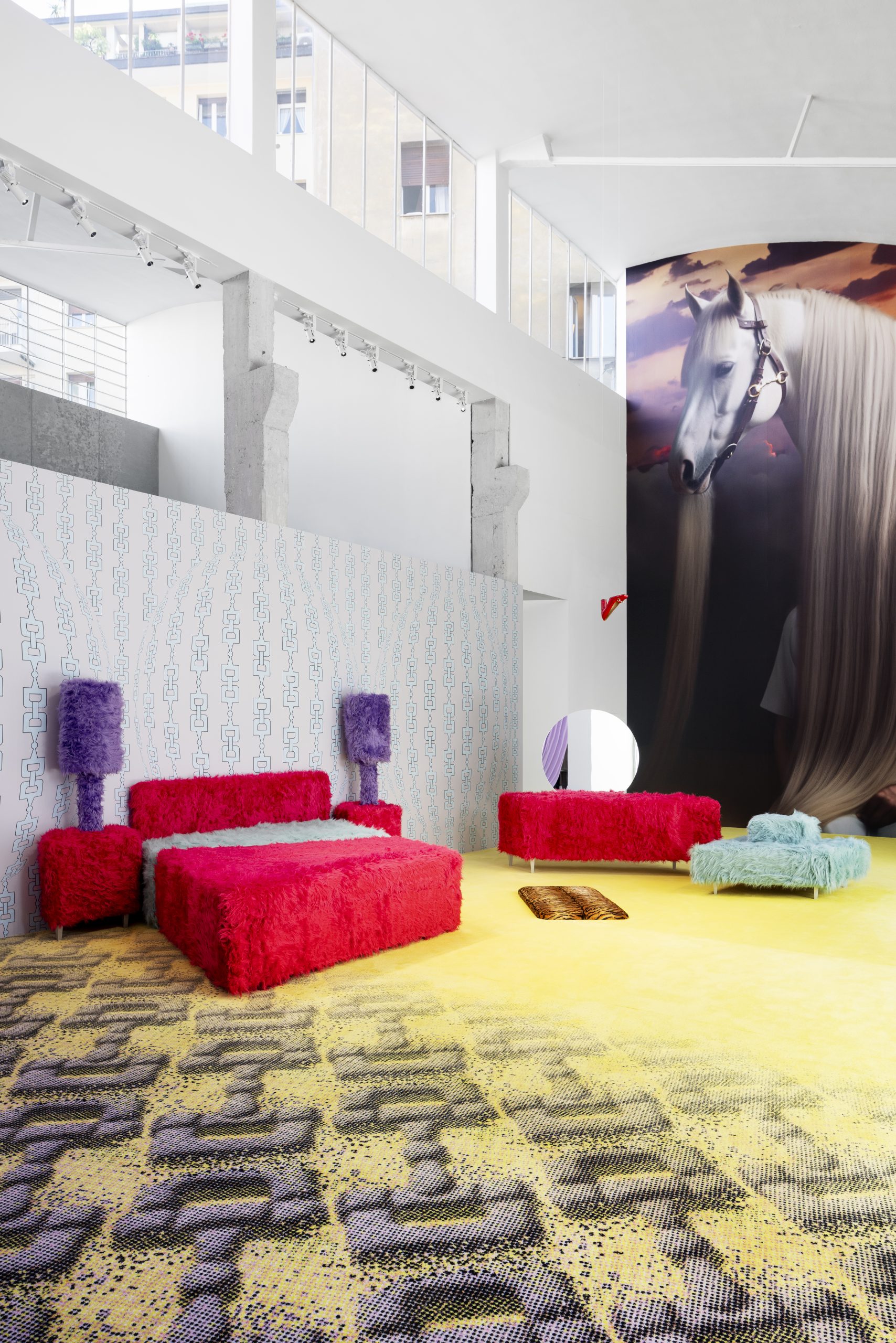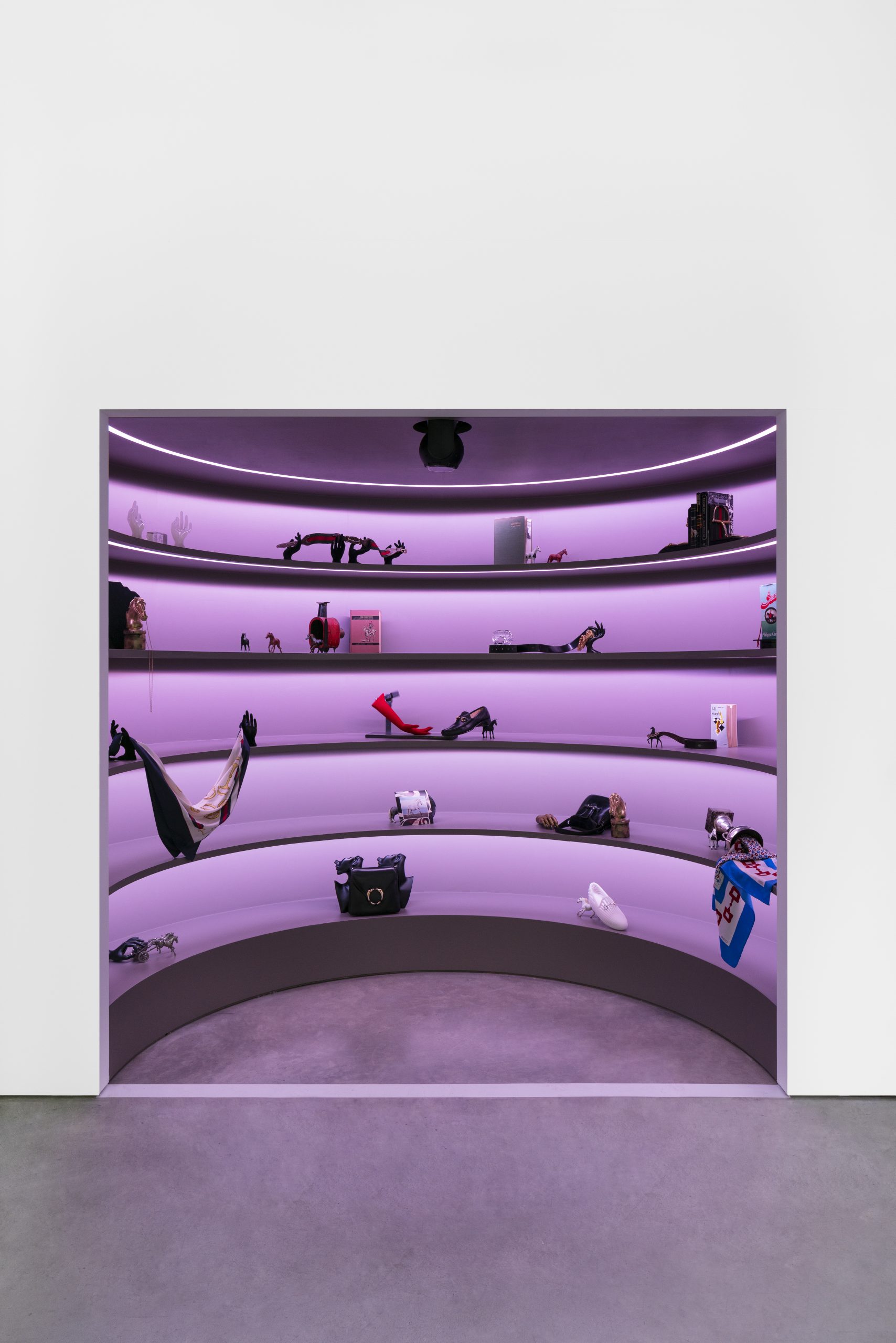Gucci’s theatrics took a different turn this season. The usual opener of Milan Men’s Fashion Week presented their new collection through the mode of an exhibition in conjunction with the 70th anniversary of their signature footwear — the Horsebit Loafer.
Being no less of a spectacle than any of their fashion shows, the exhibition — cleverly titled Gucci Horsebeat Society — took place at the art venue of Spazio Maiocchi, and was designed to be a multi-disciplinary immersive experience that spans installations, performances and videos curated by Alessio Ascari, Spazio Maiocchi’s creative director.
 The exhibition took visitors through various interpretations of Gucci’s iconic leitmotif — the Horsebit, through the lens of ten rising international artists in the forms of fashion, art or audio-visual works. Having its origins as an embellishment to a loafer, the Horsebit which originated in 1953 by Aldo Gucci, has since become a symbol associated with luxury and timelessness.
The exhibition took visitors through various interpretations of Gucci’s iconic leitmotif — the Horsebit, through the lens of ten rising international artists in the forms of fashion, art or audio-visual works. Having its origins as an embellishment to a loafer, the Horsebit which originated in 1953 by Aldo Gucci, has since become a symbol associated with luxury and timelessness.
 Taking inspiration from the House’s equestrian heritage, the exhibition used the idea of the traditional country club and morphed it into a psychedelic space that encourages the spirit of artistic counterculture. Different rooms showcase unique artworks that coincide with the concept of a house. For instance, a personal favourite, Sylvie Fluery’s ‘Bedroom Ensemble II’ renders the intimate space of a bedroom in vibrant moquette, setting the stage for Tom Ford’s era red Gucci Horsebit pumps to hover in mid-air. The legs of a 9m dining table now sport bootcut trousers and the Horsebit Loafers, the lens of American sculptor Pitterpatter recreating the idea of a dinner party.
Taking inspiration from the House’s equestrian heritage, the exhibition used the idea of the traditional country club and morphed it into a psychedelic space that encourages the spirit of artistic counterculture. Different rooms showcase unique artworks that coincide with the concept of a house. For instance, a personal favourite, Sylvie Fluery’s ‘Bedroom Ensemble II’ renders the intimate space of a bedroom in vibrant moquette, setting the stage for Tom Ford’s era red Gucci Horsebit pumps to hover in mid-air. The legs of a 9m dining table now sport bootcut trousers and the Horsebit Loafers, the lens of American sculptor Pitterpatter recreating the idea of a dinner party.
Meanwhile, the cinema room is decorated with light sculptures made with GG-printed hanji papers by Korean artist Gyuhan Lee, backed by British photographer and filmmaker, Bolade Banjo’s film that narrates and visualizes the multi-generational impact of the Horsebit.
 The exhibition aptly concludes with the ‘closet’, which unveils the SS24 collection. Mannequins stood on platforms, donning on the collection in a room covered with wallpaper created by image-maker Ed Davis, whose collages not only decorated walls but were also transposed onto an oversized silk skater ensemble.
The exhibition aptly concludes with the ‘closet’, which unveils the SS24 collection. Mannequins stood on platforms, donning on the collection in a room covered with wallpaper created by image-maker Ed Davis, whose collages not only decorated walls but were also transposed onto an oversized silk skater ensemble.
 Designed by the in-house design team, the overall direction of the collection was kept simple. Where there would usually be ornamentation, there were pieces that leaned towards a classic look. Suits were elongated in the body but cropped at the sleeves, with 70s-era bootcut trousers as a choice for pants. The familiar glitz of Gucci came sparingly with a metallic hoodie and shorts, woven with the GG logo but looked as if it was made out of liquid metal. The last look carried an apt extravagance apt of a final look with a Canadian tuxedo, encrusted with micro mirrors that immediately brought to mind a disco ball.
Designed by the in-house design team, the overall direction of the collection was kept simple. Where there would usually be ornamentation, there were pieces that leaned towards a classic look. Suits were elongated in the body but cropped at the sleeves, with 70s-era bootcut trousers as a choice for pants. The familiar glitz of Gucci came sparingly with a metallic hoodie and shorts, woven with the GG logo but looked as if it was made out of liquid metal. The last look carried an apt extravagance apt of a final look with a Canadian tuxedo, encrusted with micro mirrors that immediately brought to mind a disco ball.
Overall, Gucci’s SSS24 collection was compact and concise, made for and during what will be one of the most introspective periods for the brand. The Horsebeat Society is a serendipitous reminder of the legacy that Gucci carries — a timely revision of longstanding house codes before it takes in its last, deep breaths for the arrival of a new creative helm under the Italian house’s next creative director, Sabato de Sarno.